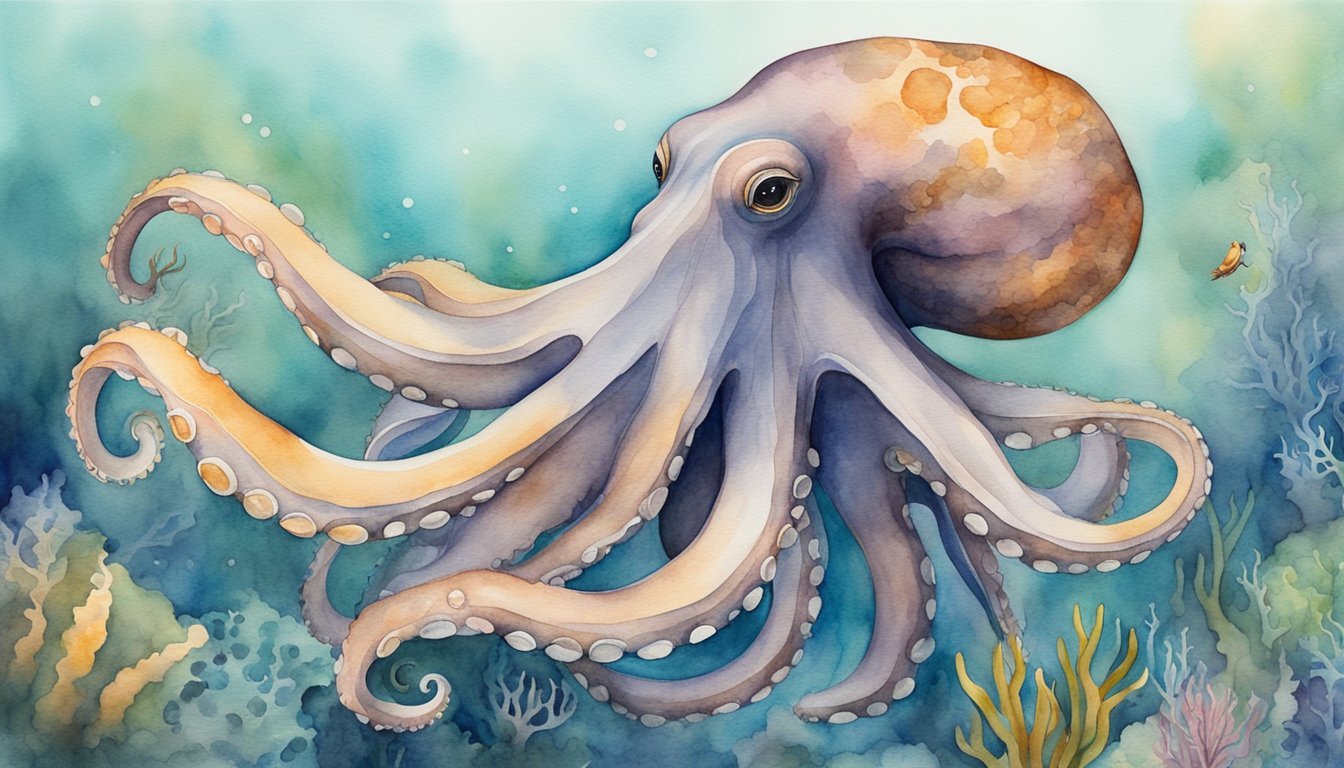Giant Octopus Biology and Behavior
Giant octopuses, particularly the Giant Pacific octopus, are among the most remarkable invertebrates in the ocean, boasting unique features and engrossing behaviors that showcase their adaptability and intelligence.
Physical Characteristics and Abilities
The Giant Pacific octopus (Enteroctopus dofleini) is renowned for being the largest octopus species. They exhibit a considerable size variance, with an impressive record of an individual weighing 600 pounds, extending 30 feet across. Normally, these cephalopods have a much smaller average size, but still possess a remarkable strength in their eight arms, each lined with two rows of powerful suckers. Their beak, hidden beneath the mantle, can crack hard shells, making them effective predators.
One of the giant octopus’s most extraordinary abilities is its camouflage. Its skin contains chromatophores, pigment cells that change color and texture to blend into surroundings, aiding in the predator’s approach and evasion from threats. Moreover, the giant octopus can navigate its habitat using visual landmarks and the topography of the sea floor.
- Largest Octopus Species: Enteroctopus dofleini
- Average Weight: Up to 110 pounds in adulthood
- Arm Span: Radiating up to 14 feet
- Camouflage: Utilizes chromatophores for rapid color change
In their nervous system, a significant portion of their neurons are located in their arms, which allows a high degree of autonomy and the ability to solve complex problems like opening jars to reach prey. Their diet typically consists of crustaceans, fish, and occasionally, small sharks.
Lifecycle and Reproduction
The lifecycle of a Giant Pacific octopus starts as one among thousands of larvae hatched from eggs laid by a female in her den. After hatching, the larvae remain planktonic before settling to the bottom and developing into juveniles and, eventually, adults.
Reproduction marks the final stage in the giant octopus’s lifespan. When ready to mate, a male octopus will use a specialized arm, called a hectocotylus, to transfer sperm packets (spermatophores) to the female. The female then lays tens of thousands of eggs, guarding them until they hatch. Following this, both males and females will die, completing a lifespan that usually lasts between three to five years.
- Reproduction Method: Males transfer spermatophores to females
- Egg Quantity: Up to tens of thousands
- Lifespan: 3 to 5 years
These octopuses are generally solitary, coming together only for the purpose of mating. Environmental conditions like temperature and availability of food influence their mating behavior and lifespan. Changes in ocean conditions, such as pollution levels and climate change, could potentially impact their reproduction and population numbers. Conservation efforts are crucial for monitoring and maintaining healthy populations in their natural habitats, spanning from the temperate waters off California to Alaska and across to Japan in the Pacific Ocean.
Conservation and Human Interaction

Giant Pacific octopuses play a significant role in marine ecosystems, but they face several threats that necessitate conservation efforts. Understanding these challenges and how humans can minimize impacts is vital for the species’ future.
Threats and Environmental Impact
The Giant Pacific octopus is susceptible to changes in environmental conditions, including those caused by climate change, which can alter the ocean’s temperature and chemistry. Pollution levels, particularly from runoff and plastic waste, also pose a significant threat to their habitat. While not currently listed as endangered on the IUCN Red List, giant Pacific octopuses are affected by overfishing, as they are sometimes caught as bycatch in fisheries targeting other species. Predation by natural predators like sea otters, harbor seals, and sperm whales can influence their population numbers, but human-caused factors like pollution, habitat destruction, and disease from polluted waters are larger concerns for their conservation status.
Human Interactions and Protection Efforts
Human activities have a considerable impact on giant Pacific octopuses, which inhabit coastal waters off Washington, Oregon, British Columbia, Korea, and Russia. While not all interactions are detrimental—marine protected areas and sanctuaries provide safe habitats—negative effects from overfishing and coastal development can lead to habitat destruction. Conservation efforts are vital and include fishing policies that reduce bycatch, promoting public awareness through science education and research, and perhaps implementing trade restrictions under the Convention on International Trade in Endangered Species of Wild Fauna and Flora (CITES) to prevent unsustainable exploitation of species that are considered commercially valuable.
- Pollution Reduction: Efforts to reduce ocean pollution, including plastic waste, can improve the habitat quality for these octopuses.
- Research and Monitoring: Understanding the species’ biology and ecology is crucial, and ongoing scientific research can offer insights into maintaining healthy populations.
- Education Programs: Informing the public about the ecological role of the giant Pacific octopus can foster support for conservation measures.
Engaging in these protection efforts is necessary to ensure that the magnificent giant Pacific octopus remains a thriving part of our world’s oceans.

